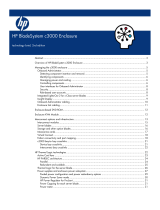Blade Servers and
Enclosures in Circuit
1 Enclosures 2 Enclosures 2 Enclosures
Power Provisioning
Cost Per Server
@ $25k per kW
$13,438 $7,679 $6,719
* While technically more than 16 blade servers will fit, the number of incremental servers does
not justify the purchase of an additional enclosure.
HP Note
Tests assume a 30 AMP, 208 V 3-phase circuit for a usable
total of 8.6 kW of capacity.
As with rack-mounted servers, customers who have used faceplate as their primary means of
budgeting server power will see the most dramatic increase in servers per circuit and the most
dramatic decrease in power provisioning cost per server. Since Dynamic Power Capping for
blades is implemented within the blade enclosure and power budgets can be adjusted
dynamically in response to workload requirements, many end-users will be able to reclaim
additional power capacity by setting caps lower than the values suggested by the SpecJBB
benchmark. In addition, because server workloads within the enclosure peak and decline at
different rates, setting a cap below SpecJBB benchmark levels will probably result in little to no
performance loss.
There are a couple of other important observations to make when looking at the data in tables 1,
2, and 3. First, while the increase in number of server per circuit is very dramatic with the
ProLiant DL380 G5, the overall number of blade servers deployed per circuit is still larger (32
blades for the BL460 G5 vs. 28 blades for the BL460 G1 vs. 23 servers for the DL380 G5).
Power efficiency built into the c-Class blades in the form of pooled power, means that more
blades can fit on a circuit even when Dynamic Power Capping is not used. Also, power
reclamation potential is different based on different blade server models. Customers leveraging
the 2 x 220 blade or the BL260c blade may find that they can reclaim more power and more
dramatically increase server capacity than the numbers shown in this analysis might indicate.
Best Practices for Implementing Dynamic Power Capping
Establishing the dynamic power capping settings for your HP servers is an interactive process. It
starts by leveraging tools such as the HP Power Calculator or HP BladeSystem Sizer to set
Dynamic Power Capping baselines and culminates with refinement of Dynamic Power Capping
settings based on actual power usage. The first portion of this section describes the Dynamic
Power Capping configuration process for rack-mount servers using the ProLiant DL380 G5 server
as an example. The second portion of this section described the same process for HP
BladeSystem infrastructure using the ProLiant BL 460c G1 and G5 servers and the HP
BladeSystem c7000 enclosure as examples.
Dynamic Power Capping is part of HP Insight Control Environment. To begin using Dynamic
Power Capping, go to the following URL,
www.hp.com/go/ice and click buy online. This takes you
to the licensing options. There is also a free trial for HP Insight Control Environment that may
be of interest. This can be found at
www.hp.com/go/tryinsightcontrol.
Setting Dynamic Power Caps for rack-mount servers
Setting Dynamic Power Caps for rack-mount servers is simple process. It involves updating ROM
BIOS, iLO and Insight Control Environment software, setting an initial Dynamic Power Cap
baseline using HP Power Calculator, and refining Dynamic Power Cap settings based on actual
power usage. Each step in the process is outlined below. Please note that setting and adjusting
8
















